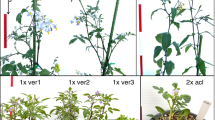Summary
A number of accessions of the three species of diploid wheat, Triticum boeoticum, T. monococcum, and T. urartu, were grown in 50 mol m-3 NaCl+2.5 mol m-3 CaCl2. Sodium accumulation in the leaves was low and potassium concentrations remained high. This was not the case in T. durum grown under the same conditions, and indicates the presence in diploid wheats of the enhanced K/Na discrimination character which has previously been found in Aegilops squarrosa and hexaploid wheat. None of the accessions of diploid wheat showed poor K/Na discrimination, which suggests that if the A genome of modern tetraploid wheats was derived from a diploid Triticum species, then the enhanced K/Na discrimination character became altered after the formation of the original allopolyploid. Another possibility is that a diploid wheat that did not have the enhanced K/Na discrimination character was involved in the hybridization event which produced tetraploid wheat, and that this diploid is now extinct or has not yet been discovered.
Similar content being viewed by others
References
Caldwell KA, Kasarda DD (1978) Assessment of genomic and species relationships in Triticum and Aegilops by PAGE and by differential staining of seed albumins and globulins. Theor Appl Genet 52:273–280
Chao S, Sharp PJ, Worland AJ, Warham EJ, Koebner RMD, Gale MD (1989) RFLP-based genetic maps of wheat homoeologous group 7 chromosomes. Theor Appl Genet 78:495–504
Dvorak J (1983) The origin of wheat chromosomes 4A and 4B and their genome reallocation. Can J Genet Cytol 25:210–214
Dvorak J, McGuire PE, Cassidy B (1988) Apparent sources of the A genomes of wheats inferred from polymorphism in abundance and restriction fragment length of repeated nucleotide sequences. Genome 30:680–689
Gill BS, Chen PD (1987) Role of cytoplasm-specific introgression in the evolution of the polyploid wheats. Proc Natl Acad Sci USA 84:6800–6804
Gill RS, Dhaliwal HS, Multani DS (1988) Synthesis and evaluation of Triticum durum — T. monococcum amphiploids. Theor Appl Genet 75:912–916
Gorham J (1987) Analysis of inorganic anions and cations in plant tissues by ion chromatography. In: Williams PA, Hudson MJ (eds) Recent developments in ion exchange. Elsevier Applied Science, London and New York, pp 14–21
Gorham J (1990a) Salt tolerance in the Triticeae: ion discrimination in rye and triticale. J Exp Bot 41:609–614
Gorham J (1990b) Salt tolerance in the Triticeae: K/Na discrimination in Aegilops species. J Exp Bot 41:615–621
Gorham J (1990c) Salt tolerance in the Triticeae: K/Na discrimination in synthetic hexaploid wheats. J Exp Bot 41:623–627
Gorham J, McDonnell E, Wyn Jones RG (1984) Pinitol and other solutes in salt-stressed Sesbania aculeata. Z. Pflanzenphysiol 114:173–178
Gorham J, Hardy C, Wyn Jones RG, Joppa LR, Law CN (1987) Chromosomal location of a K/Na discrimination character in the D genome of wheat. Theor Appl Genet 74:584–588
Gorham J, Wyn Jones RG, Bristol A (1990a) Partial characterization of the trait for enhanced K/Na discrimination in the D genome of wheat. Planta 180:590–597
Gorham J, Bristol A, Young EM, Wyn Jones RG, Kashour G (1990b) Salt tolerance in the Triticeae: K/Na discrimination in barley. J Exp Bot 41:1095–1101
Jaaska V, Jaaska U (1980) Anaerobic induction of alcohol dehydrogenase isozymes in tetraploid wheats and their diploid relations. Biochem Physiol Pflanzen 175:570–577
Johnson BL, Dhaliwal HS (1976) Reproductive isolation of Triticum boeoticum and Triticum urartu and the origin of tetraploid wheats. Am J Bot 63:1088–1094
Joppa LR, Maan SS (1982) A durum wheat disomic-substitution line having a pair of chromosomes from Triticum boeoticum: effect on germination and growth. Can J Genet Cytol 24:549–557
Joshi YC, Dwivedi RS, Qadar A, Bal AR (1982) Salt tolerance in diploid, tetraploid and hexaploid wheat. Indian J Plant Physiol 25:421–422
Kerby K, Kuspira J (1987) The phylogeny of the polyploid wheats Triticum aestivum (bread wheat) and Triticum turgidum (macaroni wheat). Genome 29:722–737
Miller TE (1987) Systematics and evolution. In: Lupton FGH (ed) Wheat breeding: its scientific basis. Chapman and Hall, London, pp 1–30
Naranjo T, Roca A, Goicoechea PG, Giraldez R (1987) Arm homoeology of wheat and rye chromosomes. Genome 29:873–882
Rana RS, Singh KN, Ahuja PS (1980) Chromosomal variation and plant tolerance to sodic and saline soils. In: Symposium papers. Proc Int Symp Salt-Affected Soil. Central Soil Salinity Research Institute, Karnal, India, pp 487–493
Rayburn AL, Gill BS (1985) Molecular evidence for the origin and evolution of chromosome 4A in polyploid wheats. Can J Genet Cytol 27:246–250
Shah SH, Gorham J, Forster BP, Wyn Jones RG (1987) Salt tolerance in the Triticeae: the contribution of the D genome to cation selectivity in wheat. J Exp Bot 36:254–269
Waines JG, Barnhart D (1990) Constraints to germplasm evaluation. In: Proc Int Symp Evaluation Utilization Genet Res in Wheat Improvement. ICARDA, Aleppo, Syria, May 1989
Waines JG, Payne PI (1987) Electrophoretic analysis of the high-molecular-weight glutenin subunits of Triticum monococcum, T. urartu, and the A genome of bread wheat (T. aestivum). Theor Appl Genet 74:71–76
Wazuddin M, Driscoll CJ (1986) Chromosome constitution of polyploid wheats: introduction of diploid wheat chromosome 4. Proc Natl Acad Sci USA 83:3870–3874
Weimberg R (1987) Solute adjustment in leaves of two species of wheat at two different stages of growth in response to salinity. Physiol Plant 70:381–388
Wyn Jones RG, Gorham J (1990) Physiological effects of salinity. Scope for genetic improvement. In: Aceredo E, Fereres E, Gimeney C, Srirastava, JP (eds) Improvement and management of winter cereals under temperature, drought and solinity stresses. INIA, Madrid, Spain (in press)
Wyn Jones RG, Gorham J, McDonnell E (1984) Organic and inorganic solute contents as selection criteria for salt tolerance in the Triticeae. In: Staples R (ed) Salinity tolerance in plants: Strategies for crop improvement. Wiley and Sons, New York, pp 189–203
Author information
Authors and Affiliations
Additional information
Communicated by J. W. Snape
Rights and permissions
About this article
Cite this article
Gorham, J., Bristol, A., Young, E.M. et al. The presence of the enhanced K/Na discrimination trait in diploid Triticum species. Theoret. Appl. Genetics 82, 729–236 (1991). https://doi.org/10.1007/BF00227318
Received:
Accepted:
Issue Date:
DOI: https://doi.org/10.1007/BF00227318




